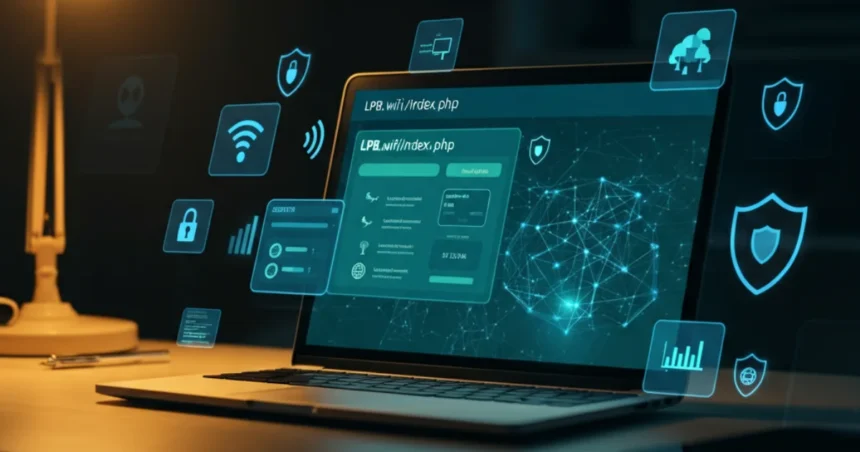When it comes to managing your Wi-Fi, accessing the lpb.wifi/index.php page is often the first step to configuring settings or resolving network issues. This web interface serves as a crucial tool for users, as it allows you to handle configurations, monitor your connection, and optimize your Wi-Fi experience.
But as helpful as this tool is, it doesn’t come without a few hiccups. Many users face recurring challenges when accessing or utilizing this web interface. The good news? These issues are usually fixable with the right know-how.
This guide will discuss what lpb.wifi/index.php does, how to troubleshoot common problems, and tips to enhance security and performance.
What is lpb.wifi/index.php?
The URL lpb.wifi/index.php typically refers to the web interface where users can access their Wi-Fi router’s settings. Through this portal, you can make adjustments such as:
- Changing your Wi-Fi name (SSID) and password
- Configuring connected devices
- Monitoring network usage
- Updating firmware
- Setting up parental controls or other advanced features
Essentially, lpb.wifi/index.php acts as the control center for your Wi-Fi network, allowing you to manage and troubleshoot your connection easily.
Common Issues with lpb.wifi/index.php
Although lpb.wifi/index.php is highly beneficial, users frequently encounter errors or roadblocks when attempting to use it. Here are the most common issues:
- Access Errors
Many users report issues with accessing the URL. This often results in error messages like “Page Not Found” or “Unable to Connect.”
- Login Problems
Forgetting your login credentials (username and password) can lock you out of the interface.
- Configuration Issues
Troubleshooting advanced features, such as port forwarding or QoS (Quality of Service), can be confusing for those not familiar with networking.
- Connectivity Interruptions
Poor Wi-Fi signals or unstable connections can interrupt your experience while accessing the portal.
Step-by-Step Guide to Troubleshoot lpb.wifi/index.php Issues
Here’s how you can fix common problems and regain control of your Wi-Fi management tool:
Step 1: Check Your Connection
Ensure that your device is properly connected to the Wi-Fi network. You can only access lpb.wifi/index.php when connected to the router.
Pro tip: If you are using an Ethernet cable, check that it is securely plugged into both the router and your device.
Step 2: Confirm the Correct URL
Sometimes, errors occur because of an incorrect URL. Double-check that you are entering the URL as lpb.wifi/index.php in your browser’s address bar.
Step 3: Restart Your Router
Power cycling your router can solve many accessibility issues. Simply turn it off, wait for 30 seconds, and turn it back on. Then, try accessing the interface again.
Step 4: Clear Your Browser Cache
A corrupted cache can sometimes block you from loading the portal. Go to your browser settings and clear the cache before reloading the page.
Step 5: Verify Login Credentials
Ensure that you’re using the correct username and password for your router. These are often found on a label attached to the back or bottom of your router. If you’ve changed the password and forgotten it, you may need to perform a factory reset on the device.
Step 6: Update Router Firmware
Outdated firmware may cause the interface to malfunction. Log in to the portal (if accessible) and check for available updates under the firmware update section.
Step 7: Factory Reset (If Necessary)
If nothing works, you can reset your router to its default settings. Look for a small reset button (usually located at the back), press and hold it for 10 seconds, and release. Note that you’ll need to reconfigure your network settings after this step.
Securing Your Connection
The lpb.wifi/index.php interface not only allows you to manage settings but also plays a key role in maintaining your network’s security. Here are some essential tips:
1. Use a Strong, Unique Password
Update your Wi-Fi password regularly. Avoid using easily guessable passwords like “12345678” or “password.” For optimal security, create a mix of letters, numbers, and symbols.
2. Enable WPA3 Encryption
Ensure that your router is using the latest WPA3 encryption standard. This will help protect your data from unauthorized access.
3. Change the Default Admin Password
Many routers come with default admin credentials, making them vulnerable to attacks. Change these during your first login to secure the interface.
4. Enable a Guest Network
If you frequently have visitors, consider enabling a guest network. This separates the main network from external devices, adding an extra layer of security.
Optimizing Your Wi-Fi Performance
Beyond troubleshooting and security, the lpb.wifi/index.php interface can help you optimize Wi-Fi performance. Here’s how:
Position Your Router Strategically
Place your router centrally in your home and away from physical obstructions or electronic devices that could cause interference.
Change the Wi-Fi Channel
If you live in a crowded area with many networks, you may experience interference. Switch to a less congested channel through the interface to improve performance.
Manage Connected Devices
Disconnect unused devices from the network to free up bandwidth for critical tasks.
Enable QoS Settings
Some routers allow you to enable QoS (Quality of Service), prioritizing certain activities such as streaming or gaming over others like downloads.
Final Thoughts on lpb.wifi/index.php
The lpb.wifi/index.php interface is your gateway to managing, securing, and optimizing your Wi-Fi connection. While it can occasionally present challenges, most issues are straightforward to resolve with basic troubleshooting steps.
By leveraging the various tools and settings available through your router’s control panel, you can ensure a fast, secure, and reliable internet experience.
For additional support, refer to your router’s user manual or contact customer service for technical assistance.






